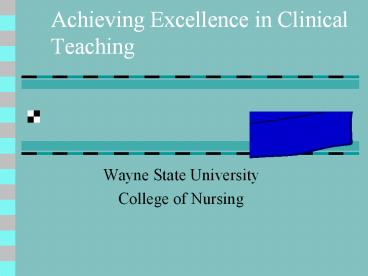Achieving Excellence in Clinical Teaching - PowerPoint PPT Presentation
1 / 44
Title:
Achieving Excellence in Clinical Teaching
Description:
Wayne State University College of Nursing Achieving Excellence in Clinical Teaching Role modeling Role modeling behaviors Professional characteristics Respectful ... – PowerPoint PPT presentation
Number of Views:28
Avg rating:3.0/5.0
Title: Achieving Excellence in Clinical Teaching
1
Achieving Excellence in Clinical Teaching
- Wayne State University
- College of Nursing
2
Acknowledgements
- We gratefully thank and acknowledge the
University of Illinois-Chicago for sharing this
presentation with us. - Special thanks to Dr. Carrie Klima for her
creativity, wisdom and sense of humor.
3
Clinical Teaching Strategies
4
What is this?
5
(No Transcript)
6
Answers???
- A. The rings of Saturn
- B. A new plan to reduce traffic congestion
- C. A model for precepting students
- D. A new approach to teach cervical dilitation
7
A model of clinical precepting!
the circle of safety
8
Faculty Boundary of Safety
9
Remember some basic principles
- Caring for patients is a shared experience
- Roles and responsibilities change over time
- Students should learn within environments that
are conducive to learning - Students learning styles vary and need to be
respected
10
Students are
- Nervous
- Anxious
- Eager to please
- In need of positive feedback
- Always challenging
11
Preceptors are
- Busy
- Eager to teach
- In need of positive feedback
12
The Circle of Safety
- Strives for consistency
- Eliminates the need for students to try and
memorize faculty preferences - Considers the faculty and student boundaries
- Allows flexibility
- Requires rationales for actions and management
plans
13
Some examples
- PROM
- Cervical ripening
- Analgesia/anesthesia
- Birth
- Speculum insertion
- contraception
14
(No Transcript)
15
What Is Evidence-Based Practice?
16
What is evidence based practice ?
- The conscientious, explicit, and current best
evidence in making decisions about the care of
individual patients. - David Sackett MD, author of Evidence based
Medicine How to practice and teach EBM. (1997)
17
History of evidence based practice
- Dr Archie Cochrane (1972 article)
- Perinatologists at Oxford University in England
published Effective Care in Pregnancy and
Childbirth (1989) a two-volume work. - Cochrane Collaboration, with multiple centers in
the US and Europe.
18
Types of Evidence
- Professional guidelines
- ACOG - practice and technical bulletins
- AWHONN guidelines
- Clinical practice protocols
- U.S. Guide to Clinical Preventive Services
19
Level I Evidence
- The Gold Standard
- At least one properly controlled randomized
clinical trial. - A study where people who are alike in all
relevant ways are randomly assigned to treatment
or control groups
20
Level II Evidence
- II-1 Controlled trials without randomization
- II- 2 Well-designed cohort and case control
studies - II-3 Cross-sectional studies, studies with
external control groups, or ecological studies
21
Level III Evidence
- Evidence derived from report of an expert
committee, which itself used a scientific approach
22
Evidence-Based Health Care
Patient preferences
Evidence based care
Expertise, skills, judgment
Best available evidence
23
(No Transcript)
24
The Art of Practice in an Evidence-Based World
- What is The Art of Practice?
- Are The Art of Practice and Evidence- Based
Practice mutually exclusive?
25
The Art of Practice in an Evidence-Based World
- Skills of artful practice
- Acute perceptive abilities
- Deep listening to speech and the body
- Control of self to match timing, touch, and
communication with the moment - Ability to change roles (authoritative with
health team to manage environment facilitative
with the women being served - (Milree Keeling, JMWH, 2002, Backpage)
26
The Art of Practice in an Evidence-Based World
- Precepting Students
- Being a Model
- Being a Learner
27
Successful Interactions
28
Goal Setting
- Institutional goals
- Compatibility institution/student/preceptor fit
- Issues time, room, patient load
- Workable solutions
- Preceptor goals
- Personal
- Professional
29
More Goals
- Adult learner goals
- Multiple learning sources
- Experience
- Example
- Discussion
- Student goals
- Assessing learner style
- Mutually agreeable goals
30
Sabinas Top 10 teaching strategies
- 1 Orientation
- 2 Clear expectations
- 3 Role modeling behavior
- 4 Attitude
- 5 Learning and teaching
- principles
31
- 6 Development of critical thinking
- 7 Time management skills
- 8 Feedback
- 9 Evaluation
- 10 Action plan
32
Orientation
- Good orientation most important
- Basics
- Personal
- Safety
- Facility
- Personnel
- Services
- Community
- Patients
- Resources
33
Expectations
- Clear expectations and parameters
- Realistic expectations
- Appropriate student preparation
- Preceptor preparation
- Safety boundaries and parameters
34
Role modeling
- Role modeling behaviors
- Professional characteristics
- Respectful
- Intentional actions
- Deliberate explanations of actions
35
Attitude
- Non-threatening
- Relaxed
- Sense of humor
- Flexibility
- Self assessment
36
Learning
- Fundamental knowledge
- Application by thinking, acting
- Integration connecting, building learning
- Human dimensions
- Motivation
- Caring
- Learning how to learn
37
Teaching Strategies
- Demonstration of skills,techniques, behaviors
- Adequate time to observe skills in action
- Involvement of clients
- Opportunities
38
Critical Thinking
- Complex process
- Thinking
- Reasoning skills
- Decision making
- Emphasis on asking questions
- Process questions
- Problem solving approaches
39
Feedback and Evaluation
- Observation
- Small segments
- Linking feedback
- Specificity to actual behavior
- Sandwich technique
- Positive/critical/positive
- Non judgmental
40
Action Plan
- Self assessment reflection
- Linking specific feedback
- Setting goals for next experience
41
Stressors
- Time
- Stressful students
- Stressful patients
- Coping strategies
- Resources
42
Assessing Clinical Performance
43
Storytelling.
44
The Faculty
- Wish to thank all of you for your expertise,
devotion, time and effort in educating the
midwives and nurse practitioners of the future.































